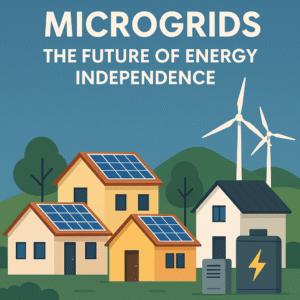Introduction: A New Era of Energy

In an age where climate change, rising energy costs, and grid instability dominate global conversations, microgrids are emerging as one of the most promising innovations in the renewable energy landscape.
A microgrid is a localized network of electricity sources and loads that can operate either connected to the main power grid or independently (island mode).
Think of it as a self-sufficient energy system that can power a campus, neighborhood, or even a small town using local renewable resources like solar, wind, and energy storage .
More than just a technological upgrade, microgrids represent a paradigm shift towards energy resilience, sustainability, and community empowerment.
The Rise of Microgrids: A Global Perspective
Here’s why microgrids are capturing attention worldwide:
Resilience: During extreme weather events like hurricanes or wildfires, microgrids keep essential services running even if the main grid fails.
Sustainability: By integrating clean energy sources, they help reduce greenhouse gas emissions and dependency on fossil fuels.
Cost Savings: Over time, producing local energy can lower costs for communities and businesses.
Energy Access: In remote areas where the main grid is unreliable or nonexistent, microgrids offer a powerful solution to energy poverty.
From California’s wildfire-prone zones to remote African villages, microgrids are fueling the decentralized energy revolution.
Real-World Impact: Inspiring Case Studies
Puerto Rico – Post-Hurricane Maria Recovery
After the devastation of Hurricane Maria in 2017, microgrids became a core part of Puerto Rico’s energy strategy. Today, solar-powered microgrids support schools, hospitals, and community centers, providing reliable, off-grid power.
India – Rural Electrification
In India, millions without dependable electricity now benefit from microgrids deployed in remote villages — empowering businesses to operate after dark and enabling children to study under proper lighting.
California, USA – Wildfire-Ready Communities
California is investing in community microgrids to ensure that critical infrastructure — fire stations, shelters, and water treatment plants — stays online during wildfire-triggered outages.
The Technology Behind Microgrids
Modern microgrids blend multiple advanced technologies:
-
Smart meters and sensors for real-time monitoring
-
Energy storage systems (like batteries) to store surplus power
-
Advanced control software for balancing supply and demand
-
AI and predictive analytics for optimizing efficiency
Future integration with blockchain, EV charging networks, and Virtual Power Plants (VPPs) will make microgrids even smarter and more connected.
The Business Case for Microgrids
For corporations, universities, and industrial parks, microgrids offer undeniable strategic advantages:
Operational Continuity: Stay functional during grid outages.
Energy Cost Optimization: Through peak shaving and demand response.
Sustainability Goals: Contribute towards ESG targets.
Enhanced Public Image: Build trust among stakeholders.
Tech giants like Google, Amazon, and Walmart are already investing heavily in microgrid technology — setting an example for the world.
Challenges and Considerations
While the future looks bright, several challenges must be addressed:
Regulatory Frameworks: Policy needs to evolve to support microgrids.
High Upfront Costs: Though long-term returns are strong.
Grid Interconnection: Technical complexities exist.
Skilled Workforce Shortages: Especially in emerging markets.
Solutions will require policy reforms, public-private partnerships, and investment in education and training.
The Road Ahead: A Resilient, Sustainable Future
Microgrids are not just a technology — they represent a vision of a resilient, clean, and inclusive energy future.
As the world moves toward net-zero emissions, climate adaptation, and energy democratization, microgrids will play a critical role.
The transition is already underway. Cities, businesses, and communities can lead by investing in microgrid solutions today.
Final Thoughts
Microgrids give us the power to rethink energy — not just how we generate it, but how we share it, store it, and use it responsibly.
They empower people, cut emissions, build resilience, and democratize access to energy.
If you’re involved in energy, urban planning, corporate sustainability, or technology, now is the time to explore how microgrids can fit into your future strategy.


Leave a Reply